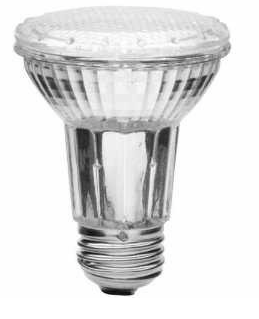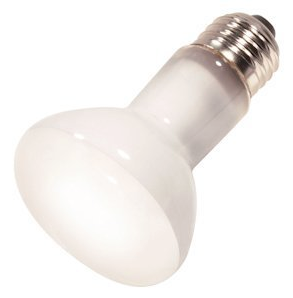For starters, let's define what a PAR20 bulb is and what this tells you. This is a relatively small bulb that measures about 2.5 inches at its widest point (across the face). This is where the "20" in the name is derived. It stands for 20 eighths of an inch, since this is how bulbs are historically measured in the United States. The P-A-R part of the name stands for Parabolic Aluminized Reflector, which is a type of reflective coating on the interior of the light that is typically used to focus or channel the light. This is often used as a spotlight or to highlight a particular area where it is desirable to project a fairly crisp outer edge to the light.
In contrast, let's take a brief look at an R20 light. As you might expect from the PAR20 description, there are a lot of similarities between these two lights. For starters, the number "20" again refers to the diameter of the light, which is 2.5 inches (20 eighths of an inch). Additionally, the R stands for Reflector, meaning that the light is again channeled forward, but instead of creating a crisp outer edge, a diffuser ensure that the light does not have a crisp of an outer edge and are therefore better for more general lighting where diffusion is desired, rather than a focused area of light. There are many different types of reflectors that make the shape of the light different, including blown, bulged, elliptical, and double, with each typically represented by the first letter and then an "R" (i.e. BR, ER, etc.), with a Blown Reflector being just an "R."
Similarities
Both bulbs have the same diameter and also typically have the same standard Edison Base, as shown in the pictures. There can be several different types of light source typically used in a PAR20 or R20 form factor including incandescent, halogen, and LED, which is why the reflective nature of the bulb is still of great use, since the incandescent and halogen bulbs emit light in all directions. However, as LEDs become more prevalent, it will be interesting to see if these same terms continue to be used, since LEDs have more directional light and may not need the same shapes and coatings to generate the desired focusing effect. I recently wrote about this and many of the other advantages to LED lighting that can be found here.
Either way, the bottom line is that a PAR20 and R20 bulb are the same size and can be used in similar situations, but the PAR20 will be better when more focused light is desired and an R20 will be better for more diffused light and general lighting situations.


 RSS Feed
RSS Feed
